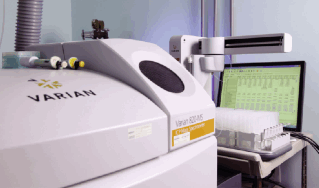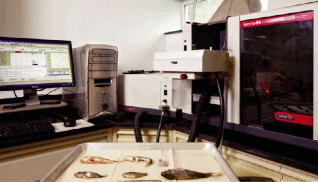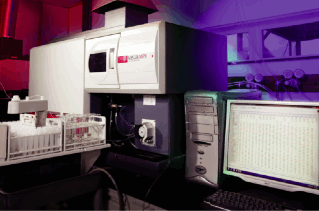In recent years, selenium has become a hot issue within the environmental community after studies linked its presence in water to mutations in aquatic life. This has led to selenium being regulated via state and federal permitting programs, and in some cases resulted in legal action being taken by environmentalists in efforts to limit selenium discharges.
Selenium is contained in soil and rock strata and when these are exposed in the course of mineral extraction it can be released into receiving streams. In order to report a result on a NPDES Discharge Monitoring Report (DMR), the sample must be analyzed by a certified laboratory using a method approved by the U.S. Environmen-tal Protection Agency (EPA), which is covered under 40CRF136. Among these currently approved methods are graphite furnace atomic absorbance (GFAA), inductively coupled plasma atomic emission spectroscopy (ICP/AES), inductively coupled plasma mass spectroscopy (ICP/MS), and gaseous hydride atomic absorbance (GHAA).

Bio-Chem’s ICP mass spectrometer.
Bio-Chem Testing has always strived to provide customers with the best available analytical data and based on West Virginia Department of Environmental Protection’s (WVDEP) Quality Assurance Office recommendations, Bio-Chem began studying the GHAA instruments on the market. Since approval of analytical methods often lags behind the development of new technologies, Bio-Chem looked at not only GHAA instruments but also gaseous hydride atomic fluorescence (GHAF) instruments. Based on a manufacturer’s touted claims of lower detection levels for GHAF technology and on existing customer testimonials, Bio-Chem decided to purchase a GHAF instrument instead of a GHAA instrument even though its use for NPDES reporting would require obtaining an Alternate Test Procedure (ATP) approval from the EPA Region III. On February 11, 2011, after completing the required comparability studies for GHAF versus ICP and ICP/MS for an ATP, Bio-Chem was granted approval to report NPDES results for selenium by GHAF by the EPA Region III Environmental Assessment and Innovation Division.
Since 2011, Bio-Chem has analyzed thousands of selenium samples by GHAF. This includes samples from coal companies, environmental consultants, and engineering firms building and operating selenium reduction and remediation pilot plants.
Some advantages, disadvantages and interferences of the various approved methods for analyzing selenium follow:
Graphite Furnace Atomic Absorption (GFAA):
Advantages: Low detection levels.
Disadvantages: Low sample throughput, expensive consumables.
Interferences: Molecular absorption — occurs when components in the sample matrix volatilize during the atomization process resulting in broadband absorption. Background correction, matrix modification, temperature ramping, method of standard additions, and the use of a graphite platform can be used to compensate.

Bio-Chem’s GFAA spectrometer.
Inductively Coupled Plasma (ICP):
Advantages: High sample throughput.
Disadvantages: Detection level may not be as low as required.
Interferences: Spectral interference — caused by the emission of light from spectral sources other than the element of interest. Judicious use of background correction positions and alternate wavelengths can be used to compensate.
Physical interferences — caused by the physical properties of the sample such as viscosity, surface tension or dissolved solids. Sample dilution, matching the calibration standards with the sample, or method of standard additions can be used to compensate.
Chemical interferences — caused by molecular compound formation, ionization effects, and thermochemical effects associated with sample vaporization and atomization into the plasma. The same techniques used for physical interferences apply along with the addition of careful selection of instrument operating conditions.
Memory interference — caused by the analyte from a previous sample being measured in the current sample and can be minimized by a sufficiently long rinse time between samples.
Inductively Coupled Plasma/Mass Spectrometry (ICP/MS):
Advantages: High sample throughput, low detection levels.
Disadvantages: In the case of selenium, disadvantages are mainly a polyatomic interference (see below).
Interferences: Isobaric interferences — caused by isotopes of other elements that form ions of the same nominal mass-to-charge ratio as the element of interest. Instrument operating software has all known isobaric interferences programmed in and automatically calculates corrections.
Abundance sensitivity — high levels of an element having an atomic mass adjacent to the atomic mass of the element of interest can obscure that analyte by tailing into its mass peak.
Polyatomic (molecular) interference — caused by the presence of ions consisting of more than one atom having a collective nominal mass-to-charge ratio the same as the element of interest. Mathematical corrections are somewhat effective in compensating for polyatomic interference as is the use of a high resolution ICP/MS. Careful adjustment of nebulizer gas flow and other instrument operating parameters can also reduce the formation of polyatomic ions. Normally, the mass of the most abundant isotope of an element would be chosen in its analysis but in the case of selenium this mass, 80Se, has the same mass charge ration, (40Ar40Ar)-, as that of a polyatomic specie known to be formed from the ICP/MS carrier gas argon in the plasma torch. Instrument manufacturers offer ways around this, but nonetheless, the method recommends the use of the 82Se mass, which only accounts for 8.73% of naturally occurring selenium as opposed to 80Se, which makes up almost 50% of naturally occurring selenium so sensitivity suffers accordingly.
Physical interferences — caused by the same properties as listed in the ICP section and compensated for similarly.
Memory interference — caused by the same situation as in the ICP section and compensated for similarly.
Ionization interferences — result from the suppression of the analyte’s signal by a matrix ion present in as little as 0.1 to 1%. Ionization interference can be corrected through the use of internal standardization techniques.

One of Bio-Chem’s ICP spectrometers.
Gaseous Hydride Atomic Absorption (GHAA):
Advantages: High sample throughput, low detection levels, selenium in sample is converted to a gas leaving potentially interfering substances present in sample in the reaction vessel.
Disadvantages: Oxidation state of selenium must be Se(IV) for hydride formation to occur. This is achieved by a two-step digestion process.
Interferences: Free chlorine, which is sometimes found as an impurity in the Hydrochloric Acid used in sample preparation, oxidizes the selenium hydride and contaminates the hydride generator. Excess oxidant remaining from the sample digestion can also oxidize the hydride. Nitrite at concentrations as low as 10 µg/L has been shown to suppress recovery by more than 50%. However this has not been observed by Bio-Chem, in fact the recommended sample treatment to eliminate Nitrite interference actually lowered selenium recoveries in our comparability studies. Copper, nickel, and lead at concentrations of 1mg/L or greater, as well as other hydride forming metals including arsenic, can suppress the recovery of selenium. Standard methods states that post digestion spike recoveries of less than 90% should lead to the consideration of other analytical procedures.
The technology for analyzing selenium by GHAF gives an accurate quantification of selenium in a sample. The main advantage beyond quick turnaround and low cost compared to other approved low-detection level methods is its immunity to most interfering agents likely to be present in mine discharge waters. These interferences can and do bias some of the other available technologies toward giving high, and thus, non-compliant results. This can make a big difference if the selenium present is at or near the discharge limit.
Mukesh Shah is president of Bio-Chem Testing Inc., which is located in Hurricane, W.Va. He can be reached at: 304-757-8954 (Email: mshah@biochemtesting.com). John Joseph is quality assurance officer for Bio-Chem Testing. He can be reached by email at jjoseph@biochemtesting.com.


